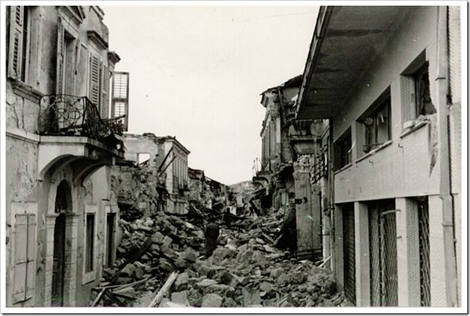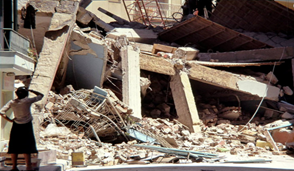Historical disasters
2. Earthquakes
2.1. Greece
The high seismic activity of the country is due to the fact that it is located at the boundary of the Africa-Eurasia convergence. Within this framework, the Anatolian plate rotates counterclockwise. From the west, the Adria microplate rotates counterclockwise. As a consequence, the Aegean a general compressional stress field and the inner Aegean area experiences a general extensional stress field.
Greece often hosts large magnitude earthquakes, whilst a moderate or small magnitude earthquake is felt every 2-3 days on average. Although the majority of these earthquakes are shallow, a few cases have been recorded as «devastating» for the human environment or for life loss (e.g. the 1881 Chios, 1953 Kefalonia, 1999 Athens earthquakes). No historical information is provided for extensive migration of populations and obliteration of civilizations in Greece due to earthquakes.
 |
 |
|---|
Assiros, Thessaloniki 1902 Earthquake measuring 7.9 on the Richter scale struck on August 11, 1902 the area of Assiros in Thessaloniki. Five people were killed.The damage to brick buildings was big,especially in Assiros as well as in Langada and in Agios Vasilios. In Thessaloniki many buildings had problems as well as the port, but only few of them had serious damages. The largest of the cracks observed in the soil had length 100m.
Athos, Chalkidiki 1905 In november 1905 a 7.5 Richter scale earthquake hit the Mt. Athos Peninsula. The epicentre was located near the monastery of Stavronikita as to be seen on this map. There was damage in Karyes, Lavra, Kavsokalivia and many other places. The earthquake caused also a huge stone avalanche on the south slope of the mountain near Ag. Nelios.
Ierissos, 1932 The 1932 Ierissos earthquake occurred at 19:20 on 26 September. It caused severe damage in Ierissos and the surrounding part of the Chalkidiki peninsula, with 491 casualties reported. The Aegean Sea is an area of mainly extensional tectonics caused by the subduction of the African Plate beneath.The earthquake has been attributed to movement on the Stratoni fault, one of the W-E trending faults that shows predominantly dip-slip extension. The earthquake destroyed the town of Ierissos and several villages in the surrounding area. 10,000 people were left homeless. The cost of the damage was estimated at 5 million drachmas. The 1932 Ierissos earthquake occurred at 19:20 on 26 September. It caused severe damage in Ierissos and the surrounding part of the Chalkidiki peninsula, with 491 casualties reported. The Aegean Sea is an area of mainly extensional tectonics caused by the subduction of the African Plate beneath.The earthquake has been attributed to movement on the Stratoni fault, one of the W-E trending faults that shows predominantly dip-slip extension. The earthquake destroyed the town of Ierissos and several villages in the surrounding area. 10,000 people were left homeless. The cost of the damage was estimated at 5 million drachmas. The earthquake was followed by three strong aftershocks (M=6.0, 5.7 & 6.2) in the period 26–29 September, and the largest (M6.3) on 11 May of the following year.
Thessaloniki, 1978 The Great Thessaloniki earthquake occurred on 20 June at 23:03 local time. The shock registered 6.2 on the moment magnitude scale, had a maximum Mercalli intensity of IX (Violent), and was felt throughout northern Greece, Yugoslavia and Bulgaria. It was the largest event in the area since the 1932 Ierissos earthquake.The epicenter was 20km east of Thessaloniki between lake Koronia and Volvi, in the village of Stivos. It lasted 10 seconds. There was a series of pre-earthquakes with stronger that of size 5.8 degrees on the Richter scale on 25-05-1978 which caused damages on buildings such as the cathedral of Thessaloniki. It also followed a series of powerful aftershocks with stronger that of 5. degrees on the Richter scale in 7-05-1978 with epicenter the Lake of Koronia (7,0 - 10,0 km from the town).
49 were dead, 220 were injured, 800.000 were left homeless either because their homes were destroyed or because they did not dare to use them. The collapse of a eight-storey building in Hippodrome Square wreaked havoc as 29 were killed out of the total 49 victims. Moreover, there have been serious damages in historic sites such us Rotonda, the church of Agia sofia and Church of the Acheiropoietos. The total cost of repair was estimated at 3-5 billion euros.